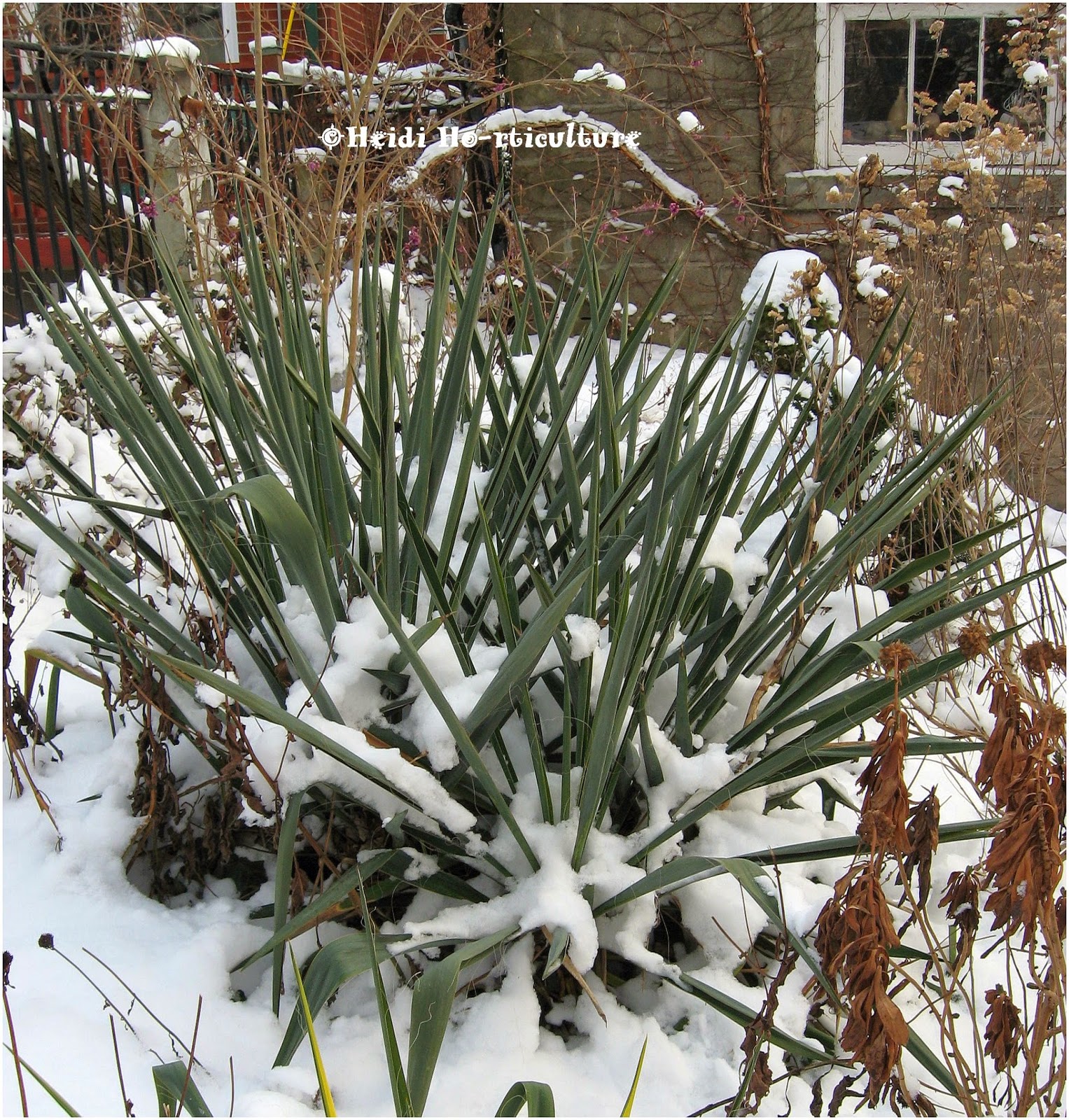 |
| When healthy, even snow won't weigh down older yucca leaves. |
Yucca filamentosas expand and grow to become clumps. They flower generally after they reach 2 to 3 years in age.
A long spike of white flowers emerges from the centre of each plant in late June and blooms for about 3 weeks. Once the flower stalk begins to go to seed, the flowered plant begins to whither and die back. The trick is to peak beneath the foliage in order to find little plants emerging from the base. Sometimes, if the 3 year old original plant starts to fade and wilt over, it smothers the young, new growth that will come from the root system. You must cut out the parent plant and allow the younger ones to breathe and emerge properly. Parent plants will not re-bloom.
Yuccas have deep root tubers. They can go down to 24" or more. Tough plant to dig out. Once the parent plant dies back with the old flower stock, the base of the plant begins to rot and can cause other smaller roots to rot with it. As the foliage starts to brown, the plant beneath loses vigor and it will fall on to itself. Making it rather untidy.
 |
| Like I did here, cut the whole parent plant out. Be sure it has the flower stalk like this one. |
 |
| It is easiest to cut out with open pruners, using the blade like a knife and slice it out as close to the ground as possible. They are like potatoes, quite juicy. |
 |
| Lift up all the blades of yucca and remove any discoloured or brown leaves from the stem. |
 |
| Pull down on the leaves - quite hard. |
 |
| Like celery, they snap clear off the stem without causing damage. If you yank on them upward, you can yank the whole stem away from the root. Always pull downwards. |
Old, dry, and damaged blades of foliage should be completely removed, not cut out. You'll need to do this in succession. Leaves wrap around the stem as it whorls up to the centre. Remove each this way, and they will come off with ease. Ripping them out of sequence will damage the stem or leave remnants of the leaf base still attached. These will whither and rot, causing some rot to occur at the root level. You want good air circulation to strengthen the stem.
Yuccas will force new growth from the centre, adding newer leaves during the growing season. Within a growing season, they will become deep green again. Much needed light and air then can help newer growth emerge and keep your yuccas looking vibrant and not limp or discoloured.
Winter maintenance:
 |
| Tough winters can cause this - half the foliage yellowing and the main core limp. |
By removing older plants, newer plants will take over and you will be able to enjoy yuccas in your garden for a very LONG time, without them looking like they need to be yanked out.
Two months after my TLC, this is the same clump of yuccas flourishing again:





Great how-to, Heidi!
ReplyDeleteThanks, Helen!
DeleteThanks a lot for the steps! Did you ever try growing in pots? Should I simply cut the new Yucca plants from the Yucca mother plant and plant them in separate containers? I have the mother plant in the center and 4 small pups around it that seem to be attached to its roots.
ReplyDeleteThanks again!
Can't say I have ever tried to grow these cold climate yucca's in pots, as they require a fair bit of depth for their tap roots. I have however grown the tropical varieties in the way you have described. The mother plant eventually dies with the cold climate (Yucca filamentosa), but by all means you can try. I would cut the mother plant down as far as one can and the babies beneath will fill out to cover any remaining stalk left behind.
Delete